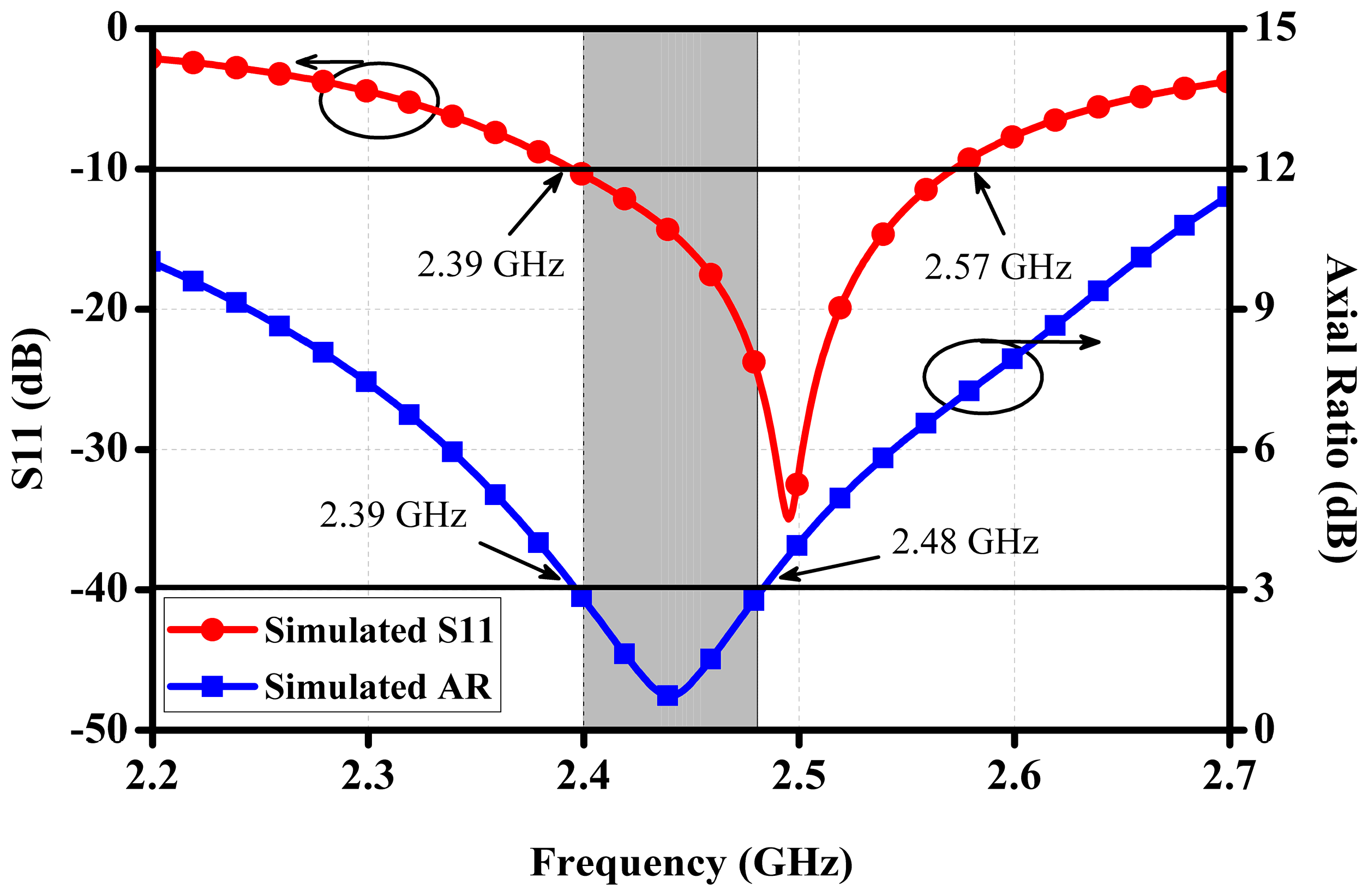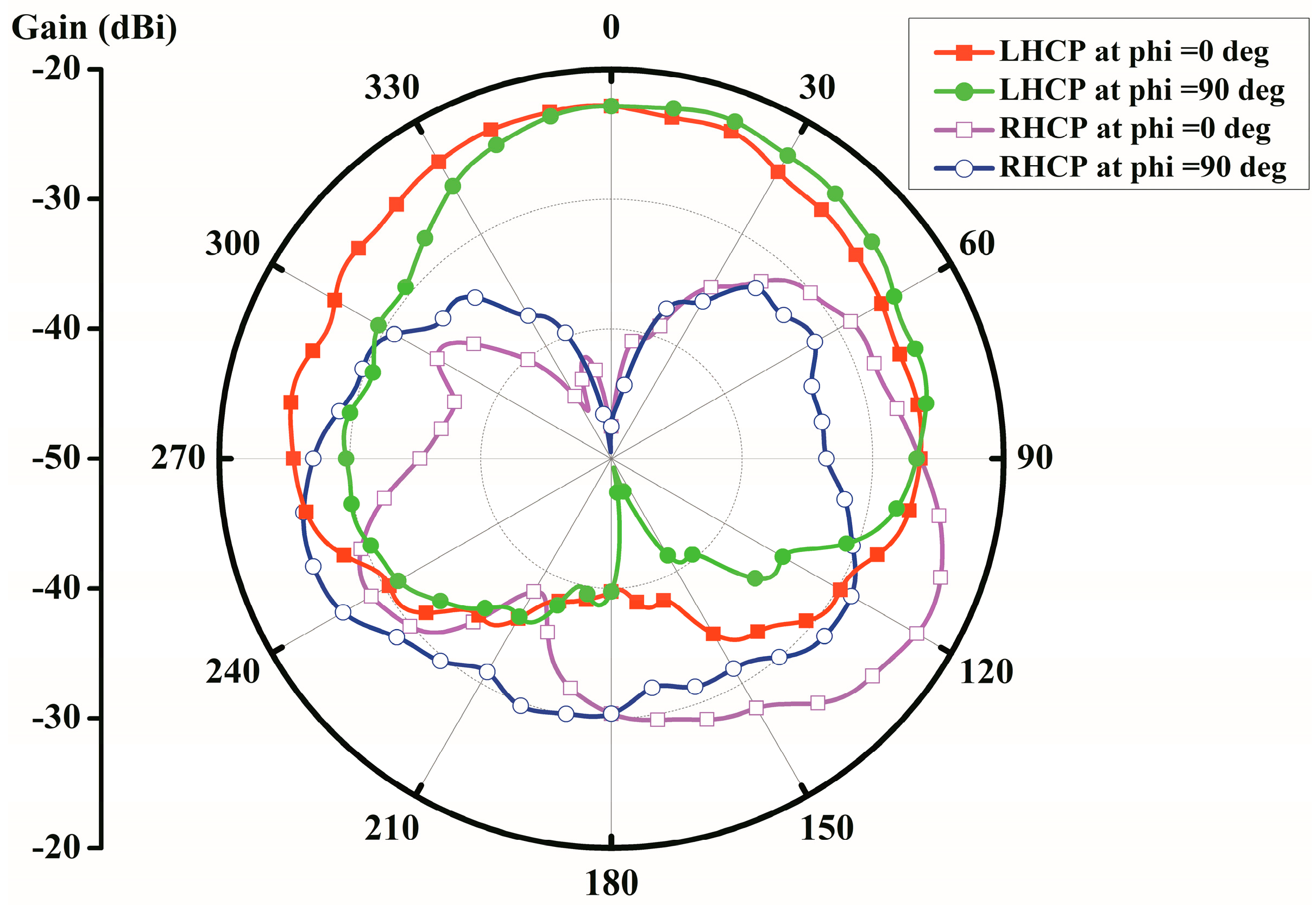A Miniaturized Circularly-Polarized Antenna for In-Body Wireless Communications
Abstract
:1. Introduction
2. Antenna Design and Simulation
2.1. Simulation Environment
2.2. Geometry of the Proposed Circularly-Polarized Antenna
2.3. Simulated Results
3. Antenna Analysis
3.1. Miniaturization of the Proposed Antenna
3.2. CP property of the Antenna
3.3. Parameter Studies
3.4. Safety Consideration
4. Experimental Results
5. Conclusions
Author Contributions
Funding
Acknowledgments
Conflicts of Interest
References
- Kiourti, A.; Nikita, K.S. A review of implantable patch antennas for biomedical telemetry: Challenges and solutions. IEEE Trans. Antennas Propag. Mag. 2012, 54, 210–228. [Google Scholar] [CrossRef]
- Soontornpipit, P.; Furse, C.M.; Chung, Y.C. Design of implantable microstrip antenna for communication with medical implants. IEEE Trans. Microw. Theory Tech. 2004, 52, 1944–1951. [Google Scholar] [CrossRef]
- Damis, H.A.; Khalid, N.; Mirzavand, R.; Chung, H.; Mousavi, P. Investigation of epidermal loop antennas for biotelemetry IoT applications. IEEE Access. 2018, 6, 15806–15815. [Google Scholar] [CrossRef]
- Neihart, N.M.; Harrison, R.R. Micropower circuits for bidirectional wireless telemetry in neural recording applications. IEEE Trans. Biomed. Eng. 2005, 52, 1950–1959. [Google Scholar] [CrossRef] [PubMed] [Green Version]
- Liu, X.Y.; Wu, Z.T.; Fan, Y.; Tentzeris, E.M. A miniaturized CSRR loaded wide-beamwidth circularly polarized implantable antenna for subcutaneous real-time glucose monitoring. IEEE Antennas Wirel. Propag. Lett. 2017, 16, 577–580. [Google Scholar] [CrossRef]
- Shah, S.A.A.; Yoo, H. Scalp-implantable antenna systems for intracranial pressure monitoring. IEEE Trans. Antennas Propag. 2018, 66, 2170–2173. [Google Scholar] [CrossRef]
- Hall, P.S.; Hao, Y. Antennas and Propagation for Body-Centric Wireless Communications, 2nd ed.; Artech House: Norwood, MA, USA, 2012. [Google Scholar]
- Huang, F.J.; Lee, C.M.; Chang, C.L.; Chen, L.K.; Yo, T.C.; Luo, C.H. Rectenna application of miniaturized implantable antenna design for triple-band biotelemetry communication. IEEE Trans. Antennas Propag. 2011, 59, 2646–2653. [Google Scholar] [CrossRef]
- Duan, Z.; Guo, Y.X.; Xue, R.F.; Je, M.; Kwong, D.L. Differentially-fed dual-band implantable antenna for biomedical applications. IEEE Trans. Antennas Propag. 2012, 60, 5587–5595. [Google Scholar] [CrossRef]
- Kiourti, A.; Nikita, K.S. Miniature scalp-implantable antennas for telemetry in the MICS and ISM bands: Design, safety considerations and link budget analysis. IEEE Trans. Antennas Propag. 2012, 60, 3568–3575. [Google Scholar] [CrossRef]
- Merli, F.; Bolomey, L.; Zurcher, J.F.; Corradini, G.; Meurville, E.; Skrivervik, A.K. Design, realization and measurements of a miniature antenna for implantable wireless communication systems. IEEE Trans. Antennas Propag. 2011, 59, 3544–3555. [Google Scholar]
- Warty, R.; Tofighi, M.R.; Kawoos, U.; Rosen, A. Characterization of implantable antennas for intracranial pressure monitoring: Reflection by and transmission through a scalp phantom. IEEE Trans. Microw. Theory Tech. 2008, 56, 2366–2376. [Google Scholar] [CrossRef]
- Xu, L.J.; Guo, Y.X.; Wu, W. Miniaturized dual-band antenna for implantable wireless communications. IEEE Antennas Wirel. Propag. Lett. 2014, 13, 1160–1163. [Google Scholar]
- Izdebski, P.M.; Rajagopalan, H.; Rahmat-Samii, Y. Conformal ingestible capsule antenna: A novel chandelier meandered design. IEEE Trans. Antennas Propag. 2009, 57, 900–909. [Google Scholar] [CrossRef]
- Liu, Y.; Chen, Y.; Lin, H.; Juwono, F.H. A novel differentially fed compact dual-band implantable antenna for biotelemetry applications. IEEE Antennas Wirel. Propag. 2016, 15, 1791–1794. [Google Scholar] [CrossRef]
- Xu, L.J.; Guo, Y.X.; Wu, W. Dual-band implantable antenna with open-end slots on ground. IEEE Antennas Wirel. Propag. Lett. 2012, 11, 1564–1567. [Google Scholar] [CrossRef]
- Liu, C.; Guo, Y.X.; Xiao, S. Compact dual-band antenna for implantable devices. IEEE Antennas Wirel. Propag. Lett. 2012, 11, 1508–1511. [Google Scholar]
- Liu, W.C.; Chen, S.H.; Wu, C.M. Bandwidth enhancement and size reduction of an implantable PIFA antenna for biotelemetry devices. Microw. Opt. Technol. Lett. 2009, 51, 755–757. [Google Scholar] [CrossRef]
- Jung, Y.H.; Qiu, Y.; Lee, S.B.; Shih, T.Y.; Xu, Y.; Xu, R.; Lee, J.; Schendel, A.A.; Lin, W.; Williams, J.C.; et al. A compact parylene-coated WLAN flexible antenna for implantable electronics. IEEE Antennas Wirel. Propag. Lett. 2016, 15, 1382–1385. [Google Scholar] [CrossRef]
- Duan, Z.; Guo, Y.X.; Je, M.; Kwong, D.L. Design and in vitro test of a differentially fed dual-band implantable antenna operating at MICS and ISM bands. IEEE Trans. Antennas Propag. 2014, 62, 2430–2439. [Google Scholar] [CrossRef]
- Liu, C.R.; Guo, Y.X.; Xiao, S.Q. Capacitively loaded circularly polarized implantable patch antenna for ISM band biomedical applications. IEEE Trans. Antennas Propag. 2014, 62, 2407–2417. [Google Scholar] [CrossRef]
- Liu, C.; Guo, Y.X.; Xiao, S.Q. Circularly polarized helical antenna for ISM-band ingestible capsule endoscope systems. IEEE Trans. Antennas Propag. 2014, 62, 6027–6039. [Google Scholar] [CrossRef]
- Li, R.; Guo, Y.X.; Zhang, B.; Du, G.H. A miniaturized circularly polarized implantable annular-ring antenna. IEEE Antennas Wirel. Propag. Lett. 2017, 16, 2566–2569. [Google Scholar] [CrossRef]
- Li, J.M.; Chang, T.H.; Liu, X.Y. A compact circularly polarized antenna for in-body wireless communications. In Proceedings of the 2017 IEEE International Symposium on Antennas and Propagation & USNC/URSI National Radio Science Meeting, San Diego, CA, USA, 9–14 July 2017; pp. 2593–2594. [Google Scholar]
- Chi, P.; Waterhouse, R.; Itoh, T. Antenna miniaturization using slow wave enhancement factor from loaded transmission line models. IEEE Trans. Antennas Propag. 2011, 59, 48–57. [Google Scholar] [CrossRef]
- IEEE Standard for Safety Levels with Respect to Human Exposure to Radio Frequency Electromagnetic Fields, 3 kHz to 300 GHz, IEEE Standard C95.1-2005; IEEE: New York, NY, USA, 2006; pp. 1–238.
- Yang, Z.J.; Xiao, S.Q.; Zhu, L.; Wang, B.Z.; Tu, H.L. A Circularly polarized implantable antenna for 2.4-GHz ISM band biomedical applications. IEEE Antennas Wirel. Propag. Lett. 2017, 16, 2554–2557. [Google Scholar] [CrossRef]













| Tissues | Thickness (mm) | εr | σ (S/m) |
|---|---|---|---|
| Skin | 4 | 38.0 | 1.46 |
| Fat | 4 | 5.28 | 0.1 |
| Muscle | 50 | 52.7 | 1.74 |
| Symbol | Value | Symbol | Value | Symbol | Value |
|---|---|---|---|---|---|
| L | 9.0 | W | 0.5 | L1 | 4.6 |
| L2 | 1.8 | L3 | 0.6 | L4 | 0.4 |
| L5 | 6.4 | L6 | 0.8 | L7 | 2.6 |
| L8 | 2.2 | L9 | 0.9 | d | 3.5 |
| g | 0.1 | H1 | 1.8 | H2 | 1 |
| Ref. | Dimensions (mm × mm × mm) | Bandwidth | Peak Gain (dBi) | |
|---|---|---|---|---|
| (S11 < −10 dB) | (AR < 3 dB) | |||
| [5] | 8.5 × 8.5 × 1.27 (92 mm3) | 2.32–2.62 GHz (~12.2%) | 2.42–2.48 GHz (~2.4%) | −17 |
| [21] | 10 × 10 × 1.27 (127 mm3) | 2.36–2.55 GHz (~7.7%) | 2.44–2.48 GHz (~1.6%) | −22 |
| [23] | π × (5.5)2 × 1.27 (~120 mm3) | 2.31–2.51 GHz (~8.3%) | 2.42–2.48 GHz (~2.49%) | −22.7 |
| [27] | 10 × 10 × 1.27 (127 mm3) | 2.35–2.50 GHz (~6.2%) | 2.36–2.56 GHz (~8.13%) | −27.2 |
| This work | 9.2 × 9.2 × 1.27 (107 mm3) | 2.39–2.57 GHz (~7.2%) | 2.39–2.48 GHz (~3.7%) | −24.8 |
© 2019 by the authors. Licensee MDPI, Basel, Switzerland. This article is an open access article distributed under the terms and conditions of the Creative Commons Attribution (CC BY) license (http://creativecommons.org/licenses/by/4.0/).
Share and Cite
Fan, Y.; Liu, X.; Li, J.; Chang, T. A Miniaturized Circularly-Polarized Antenna for In-Body Wireless Communications. Micromachines 2019, 10, 70. https://doi.org/10.3390/mi10010070
Fan Y, Liu X, Li J, Chang T. A Miniaturized Circularly-Polarized Antenna for In-Body Wireless Communications. Micromachines. 2019; 10(1):70. https://doi.org/10.3390/mi10010070
Chicago/Turabian StyleFan, Yi, Xiongying Liu, Jiming Li, and Tianhai Chang. 2019. "A Miniaturized Circularly-Polarized Antenna for In-Body Wireless Communications" Micromachines 10, no. 1: 70. https://doi.org/10.3390/mi10010070





